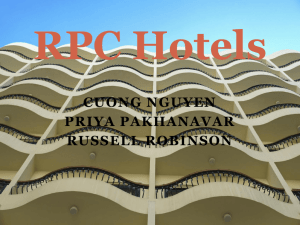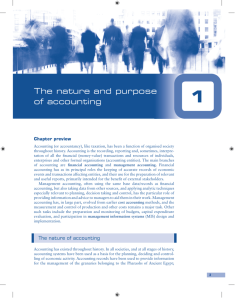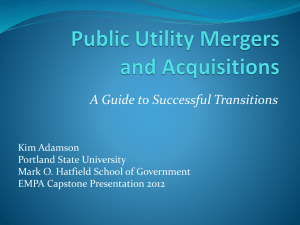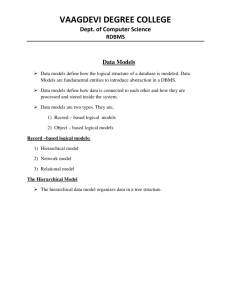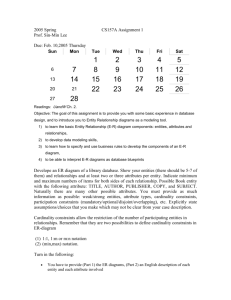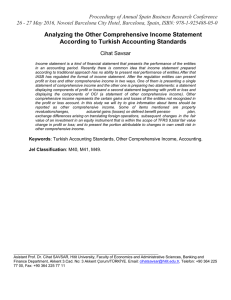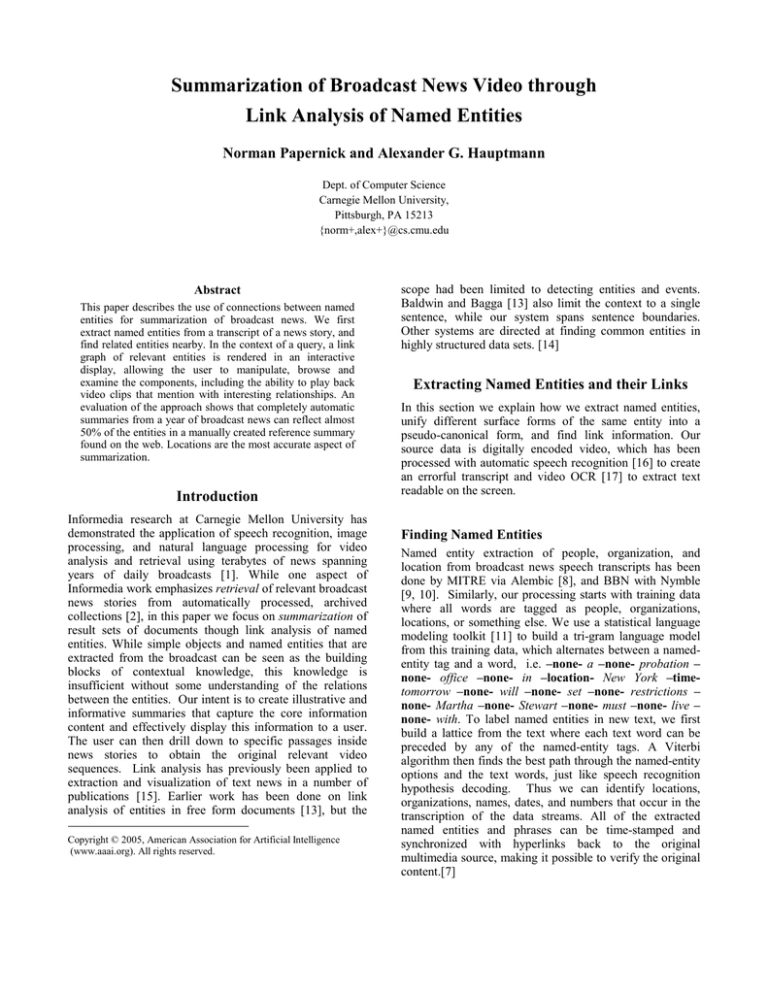
Summarization of Broadcast News Video through
Link Analysis of Named Entities
Norman Papernick and Alexander G. Hauptmann
Dept. of Computer Science
Carnegie Mellon University,
Pittsburgh, PA 15213
{norm+,alex+}@cs.cmu.edu
Abstract
This paper describes the use of connections between named
entities for summarization of broadcast news. We first
extract named entities from a transcript of a news story, and
find related entities nearby. In the context of a query, a link
graph of relevant entities is rendered in an interactive
display, allowing the user to manipulate, browse and
examine the components, including the ability to play back
video clips that mention with interesting relationships. An
evaluation of the approach shows that completely automatic
summaries from a year of broadcast news can reflect almost
50% of the entities in a manually created reference summary
found on the web. Locations are the most accurate aspect of
summarization.
Introduction
Informedia research at Carnegie Mellon University has
demonstrated the application of speech recognition, image
processing, and natural language processing for video
analysis and retrieval using terabytes of news spanning
years of daily broadcasts [1]. While one aspect of
Informedia work emphasizes retrieval of relevant broadcast
news stories from automatically processed, archived
collections [2], in this paper we focus on summarization of
result sets of documents though link analysis of named
entities. While simple objects and named entities that are
extracted from the broadcast can be seen as the building
blocks of contextual knowledge, this knowledge is
insufficient without some understanding of the relations
between the entities. Our intent is to create illustrative and
informative summaries that capture the core information
content and effectively display this information to a user.
The user can then drill down to specific passages inside
news stories to obtain the original relevant video
sequences. Link analysis has previously been applied to
extraction and visualization of text news in a number of
publications [15]. Earlier work has been done on link
analysis of entities in free form documents [13], but the
Copyright © 2005, American Association for Artificial Intelligence
(www.aaai.org). All rights reserved.
scope had been limited to detecting entities and events.
Baldwin and Bagga [13] also limit the context to a single
sentence, while our system spans sentence boundaries.
Other systems are directed at finding common entities in
highly structured data sets. [14]
Extracting Named Entities and their Links
In this section we explain how we extract named entities,
unify different surface forms of the same entity into a
pseudo-canonical form, and find link information. Our
source data is digitally encoded video, which has been
processed with automatic speech recognition [16] to create
an errorful transcript and video OCR [17] to extract text
readable on the screen.
Finding Named Entities
Named entity extraction of people, organization, and
location from broadcast news speech transcripts has been
done by MITRE via Alembic [8], and BBN with Nymble
[9, 10]. Similarly, our processing starts with training data
where all words are tagged as people, organizations,
locations, or something else. We use a statistical language
modeling toolkit [11] to build a tri-gram language model
from this training data, which alternates between a namedentity tag and a word, i.e. –none- a –none- probation –
none- office –none- in –location- New York –timetomorrow –none- will –none- set –none- restrictions –
none- Martha –none- Stewart –none- must –none- live –
none- with. To label named entities in new text, we first
build a lattice from the text where each text word can be
preceded by any of the named-entity tags. A Viterbi
algorithm then finds the best path through the named-entity
options and the text words, just like speech recognition
hypothesis decoding. Thus we can identify locations,
organizations, names, dates, and numbers that occur in the
transcription of the data streams. All of the extracted
named entities and phrases can be time-stamped and
synchronized with hyperlinks back to the original
multimedia source, making it possible to verify the original
content.[7]
Deriving Canonical Forms of Named Entities
Once we have identified the entities, we find that many
different surface forms refer to the same entity, especially
for names. Thus George Bush, George W. Bush and Bush
in the same story refer to the same person, not three
different people. To effectively create summaries, we have
to unify these different forms into one canonical name.
The following core algorithm is used to map the different
forms into a common representation.
1) For each found named entity inside a news story,
if an explicit representation for this entity exists in
an external knowledge base (e.g., President Bush
George Bush), use that canonical form.
2) If other entities of the same type in the current
story subsume the current entity as a subset,
replace this entity name with the more complete
one (e.g., Bin Laden Osama Bin Laden, if both
occur in one story).
3) If other entities of the same type in the current
complete news program subsume the current
entity, replace this entity name with the more
complete one (e.g., Bin Laden Osama Bin
Laden, if both occur in one news program).
4) If the current form of the named entity has been
referred to more than once in the history of our
process, insert it into the database as a “canonical
entity”.
This process, while conservative, helps merge some of the
similar surface forms of entities, and allows input from an
external knowledge source. Because the process is
automatic and conservative, there are a number of named
entities that occur in multiple “canonical” surface forms in
the database.
Because the process is derived from speech recognized text
or video OCR of fragments of overlaid text, a grammatical
parse is impossible, nor can we depend on spelling,
capitalization or punctuation. We must accept that there
will be substantial numbers of misidentified entities, as well
as ones that cannot be automatically merged into canonical
form.
Connecting Named Entities
In this subsection, we describe our approach to
understanding the relational context of named textual
entities, which can be viewed as a form of link analysis.
Informally, two entities are said to be connected if they are
mentioned in close proximity. Formally, we can define e as
a unique instantiation of some named entity, S as a single
sentence that is represented as a collection of named
entities, and P as a paragraph which is an ordered
collection of sentences. Given that, we can compute the
distance between any two named entities as the differences
between the indexes of the sentences that contain the
entities.
S = {eo Ken }
P = {So K Sm ∋ Si ∩ S j = φ }
sen(e) = j such that e ∈ Pj
dist (ei , e j ) = 1 + sen(ei ) − (e j )
weight (ei , e j ) =
1
(dist (ei , e j )) 2
After the distance has been computed, the weight of the
connection is computed as the square of the inverse of the
distance. For this evaluation we index all pairs that have a
distance of 3 or less. The set of all connections can be
seen as a graph where the entities are nodes and the weights
represent the edges.
Interface Features
The interface around the extracted named entities and their
link information affords a variety of presentations and
manipulations:
Initial Query. The Named Entity Connection Graph
viewer is driven by the Informedia Digital Video Library
search interface. The search can be text driven (such as
“Martha Stewart”), image driven (Query by Image
Content), or map driven (e.g., countries in North Africa).
Once a set of documents is selected, the Named Entity
Connection Search Engine returns a list of all the
connections within the set. The set can be dynamically
filtered using many different techniques. Figure 1 shows
the date slider in effect, reducing the number of active
documents to only those inside the selected range.
Ranked Ordered List of Entities. The middle right hand
portion of Figure 1 contains a scrolling list of named
entities. The list is sorted in descending order based on the
sum of the weights for all the connections for a given
entity. Each entry is color coded based on a gradient from
red to blue to represent the relative weight in relation to the
other entries. Red represents the largest sum weight, and
blue represent the lowest. Clicking on an entry will focus
the graph on that named entity.
weight (ei ) = ∑ weight (ei , e j )
Summary Graph View. The Summary Graph View as
shown in the bottom half of Figure 1 shows an overview of
how the named entities relate within a search result set.
The program Dot [12] is used to generate the graphs. The
interface uses colors, shapes, and rollovers to display the
relationships. Rectangles represent people, hexagons
represent organizations, and ovals represent locations. A
yellow fill indicates the Entity of Focus, in this example
“Martha Stewart”. Cornflower blue filled shapes are those
entities which have a direct connection to the Entity of
Focus, for this example a maximum distance of 3 is the
cutoff. Not shown in Figure 1 are shapes with white fill.
These represent the second tier of connections, entities that
are strongly connected to the blue entities. The second tier
entities are those which would be found in a breadth-first
search with depth two, starting at the Entity of Focus.
These Entities are related to the Entity of Focus, but not
mentioned in close proximity. A directly connected Entity
is displayed on in the graph if the Entity is connected inside
the subgraph by two or more segments. This removes the
noise due to broadcast news “teasers” that contain a
summary of the hour’s news stories as well false
connections due to unrelated stories being mentioned in
close proximity.
Figure 1. Summary Graph View for the initial query “Martha Stewart.”
List View. The List View represents the same connection
relations as the Summary Graph View, but in a more
compact format as seen in Figure 2. Both the Summary
Graph View and the List View share the same color fill
idiom. The List View breaks each entity type into a
separate column instead of representing type with shape.
The actual links between entities are shown when the user
moves the cursor over the entity. The selected entity is
underlined while the set of connected entities are changed
to a bold face.
Text Link View. The Text Link View is activated when the
user selects the “play” method from the Graph or List view.
The view displays the collection of sentences that are active
in the graph with respect to the selected Entity, as seen in
Figure 3.
Afforded Interface Manipulations
Figure 2. List View
Skim View. A video skim is a temporal multimedia
abstraction that incorporates both video and audio
information from a longer source. A video skim is played
rather than viewed statically, e.g., a ten-minute video
segment might be condensed to a one-minute skim [3, 4].
Skims can better summarize audio content and temporal
flow than storyboards of single thumbnail images, one
thumbnail per shot. For example, important narrative from
a single speaker could be captured in a skim, but the
storyboard would only show an image of the speaker. As
another case, an airplane looping in the sky might be
collapsed to a single shot and single image storyboard
(especially if the color characteristics remain constant), but
a skim could show the interesting motion of the airplane.
[5] The Skim View differs from the traditional skims by
representing a multi-movie video summary of the
connections related to a single named entity instead of
focusing on a single movie broadcast. The Skim View uses
the precomputed media offsets for the start and end of each
sentence to select where in the media the play list should
start and stop.
The Graph View display allows the user to manipulate the
data in many ways. Single left clicking on a shape changes
the selected entity to be the new entity of focus. The graph
is recomputed with the new entity as the center and
displayed to the user. A single right click on a shape brings
up a context menu. The entity selected will be referred to
as the local focus. The user may delete the local focus
from the graph. All connections that are dependent on only
the local focus are hidden from the display. The user can
undelete the node at any time to bring the connections back
to view. For instances when the Canonical Named Entity
process misses due to cases such as “Martha Stewart” and
“Stewart” being detected as different entities, the user can
merge the local focus with any other entity. The target
entity’s connections are absorbed into that of the local
focus. The user can activate the Skim View in two ways
from the local focus through play single or play all. Play
single will select all the sentences represented in the current
graph that are connected to the local focus and a selected
entity. Play all selects all the sentences that are connected
to the local focus in the current graph. All right click
options are available in both the Graph and the List Views.
In addition to the right click menu, the user is given a set of
buttons to interact with the display. The user can zoom
into or out from the graph. By default, the system will
resize the screen to the smallest size required to display the
entire graph without scrolling. Zooming allows the user to
inspect a complex graph closely after seeing an overview.
The user is given three filters, one for each entity type of
people, organizations, and places. Toggling each filter will
add or subtract all entities of that type from the connection
graph. There is also a toggle for the second tier of
connections. When activated, the graph will attempted to
include indirectly connected entities after adding all
possible directly connected entities. The user may also
change the cutoff for the maximum number of entities on
the screen. By default, the number is 15.
The user can actively explore the data by highlighting
different objects on the screen. When the Summary Graph
is active, highlighting a thumbnail of an image as in the
upper right hand sections of the screenshots will cause the
links that represent the same documents to highlight in the
graph. Likewise, highlighting one of the color bars that
represent sentences in the Skim View as is shown in Figure
4 will cause the related links to highlight. We refer to this
act as “Brushing” and is used in other parts of the
Informedia interface.
Figure 3. Text Summary View
Figure 4. Skim View with highlighting
Evaluation
The Named Entity Connection graph creates a summary of
the important related entities for a given entity.
To
evaluate this claim, we used infoplease.com’s list of
“People in the News” for 2004 [6]. Each of the 93 entries
contains a short description of why that person was in the
news that year. An example is the entry for Martha
Stewart:
Martha Stewart, — diva of domesticity, was
sentenced to five months in prison in July after being
found guilty on four counts of obstruction of justice
and lying to federal investigators. The judge stayed
her sentence pending appeal, but Stewart opted to
begin serving her sentence in October. She was also
fined $30,000. The charges stem from her December
2001 sale of 3,928 shares of the biotech stock
ImClone. She made the trade the day before the FDA
announced it had declined to review ImClone's new
cancer drug—news that sent shares tumbling.
In this example, there are three entities found (Martha
Stewart, FDA and ImClone) with four instantiations
(Martha Stewart, Stewart, FDA and ImClone). The test
corpus used for the evaluation contained 622 hours of
CNN broadcast news from 2004 segmented into
approximately 30,000 story documents by Informedia
processing. (Table 1)
Table 1
Video Collection in Test Suite
CNN Lou Dobbs Moneyline
CNN NewsNight with Aaron Brown
CNN Saturday
CNN Sunday
Hours
260
260
51
51
Accuracy At N Exact M atch
0.45
0.4
0.35
0.3
Accuracy
For the evaluation, a text search for the given entity was
done for each of the 93 names listed by Infoplease for
People of 2004. A text search could return anywhere from
0 to a configured maximum of 1000 documents. This set of
documents was then used to generate the graphs used for
evaluation. Only 59 of those contained at least one
connection between entities which could be displayed as a
graph. The generated graphs were set to a maximum cutoff
of 50 entities on the screen. Each graph was generated
twice, once with the Second Tier option off and once with
the Second Tier option on. The baseline, or First Tier,
option limits the graph to only those names that are directly
connected to the entity of focus. The Tier 2, or Second
Tier, allows for a greater context by considering the entities
that are directly connected to each of the linked entities. It
contains entities that would be found in a breadth-first
search with depth two, starting at the Entity of Focus. The
entities were evaluated for accuracy and error rate using the
Infoplease as truth. Two different evaluation techniques
were used:
(a) Considering each multi word entity as a single phrase
requiring an exact match and
(b) Treating the list of Named Entities as a bag of words
to allow for a flexible match.
0.25
Bas e
0.2
Tier 2
0.15
0.1
0.05
0
1
4
7 10 13 16 19 22 25 28 31 34 37 40 43 46 49
Number of Entites in Connection Graph
Figure 5. Accuracy for Exact Match direct connections
and Second Tier.
The error rate (Figure 6) of the Second Tier is lower at the
smaller cutoffs, but as more entities are allowed to be
added the improvements become marginal. In terms of
error, the Second Tier diverges at about 13 and continues
to rise.
Given the truth set T and retrieved set R for some Named
Entity, the accuracy and error are computed as follows
Error At N Exact Match
T ∩R
accuracy (T , R) =
T
0.7
(T − T ∩ R ) + ( R − T ∩ R )
T +R
0.6
Error
error (T , R) = 1 −
0.8
0.5
Base
0.4
Tier 2
0.3
0.2
The accuracy represents the total overlap between the
Infoplease truth set and a given named entity graph. This is
directly proportional to recall. The error term is directly
related to 1 minus the precision.
Results. Figure 5 shows a leveling off of accuracy of about
37% at 18 entities for exact word evaluation. The
additional context of the Second Tier levels off at around
26 entities with an accuracy of 42%.
0.1
0
1
4
7
10 13 16 19 22 25 28 31 34 37 40 43 46 49
Number of Entities in Connection Graph
Figure 6. Error for Exact Match direct connections and
Second Tier.
In the bag of words evaluation (Figure 7) the accuracy of
the direct-only connections levels off at 18 entities with
46% word coverage. The Second Tier continues to rise in
accuracy at up to 46 entities on the screen for an average
accuracy of about 53%.
Accuracy At N Bag Of Words
Frequency
0.6
Accuracy
0.5
0.4
Base
0.3
Tier 2
0.2
Graphs with at least N Entities
70
60
50
40
Base
Tier2
30
20
0.1
10
0
1
4
7
10 13 16 19 22 25 28 31 34 37 40 43 46 49
0
Number of Entities in Connection Graph
1
4
7 10 13 16 19 22 25 28 31 34 37 40 43 46 49
Number of Entities
Figure 7. Accuracy for Bag of Words direct connections
and Second Tier.
Figure 11 shows a major difference between the human
generated summaries and the automatically generated text.
The human generated summaries are shorter, containing on
average six named entities. The named entity connection
based summaries contains more than twice that of the
baseline for all cases.
The error for the Bag of Words evaluation stays in lock
step for direct-only connections at second tier up to about
12 entities in the list. The second tier error rate diverges as
the absolute number of entities being considered is
increased (Figure 9).
Figure 9. The frequency of number of entities in the
automatically generated graphs.
Figure 10 shows the average ratios of each entity type in
each evaluation. The named entity connection summaries
are evenly distributed between the three types, whereas the
truth tends to have more people and fewer locations.
Because there were fewer number of organizations in the
truth set, organizations are marginally harder to match for
most of the situations (Figure 12) Locations had a higher
accuracy for the exact match because there are fewer
variations in the presentation of location names in media.
Names match well in the bag of words evaluation because
the truth will sometimes contain an entity listed twice, once
with the full name and once with only the last name.
Error At N Bag Of Words
Ratios of Entity Types
Error
0.9
0.8
100%
0.7
90%
0.6
80%
70%
0.5
Base
Tier 2
0.4
0.3
60%
Person
50%
Organization
40%
Location
0.2
30%
0.1
20%
10%
0
1
4
7 10 13 16 19 22 25 28 31 34 37 40 43 46 49
Number of Entities in Connection Graph
Figure 8. Error for Bag of Words direct connections
and Second Tier
The shape of the accuracy and error graphs are explained
by the frequency graph in Figure 9. For any given entity,
there is a higher chance that the Second Tier graph contains
more elements than the direct graph.
0%
Exact
Match
Bag of
Words
Exact
Match
Tier 2
Bag of
Words
Tier 2
Truth
Exact
Match
Truth Bag
of Words
Figure 10. Ratios of entity types for each evaluation
category.
The human generated summaries, on average, are much
shorter than the automatically generated ones, as seen in
Figure 11.
Average Number of Entities
35
30
25
20
15
10
5
0
Exact Match
Bag of Words
Exact Match
Tier 2
Bag of Words
Tier 2
Truth Exact
Match
Truth Bag of
Words
Figure 11. Average number of entities for each
evaluation category.
Breakdown of Accuracy vs Entity Type
0.6
0.5
0.4
Location
0.3
Organization
Person
0.2
0.1
0
Exact Words
Exact Words
Tier 2
Bag of Words Bag of Words
Teir 2
Figure 12. Breakdown of Accuracy for each evaluation
category.
Conclusions and Discussion
We describe an implementation and evaluation of
techniques for generating dynamic, query-driven
summaries of links and the underlying media source
streams with respect to named entities.
The Named Entity Connection graphs shows promise in the
development of focused multi-story video summaries. The
summaries generated automatically based on a limited
database are similar to the human created summaries based
on broad knowledge of the topics. This opens the door to
future research for the application of link analysis for
summarization of video databases. It also points to
strengths and weaknesses in the underlying named entity
detection. Future evaluations should test if merging of
entities can increase accuracy due to mislabeled entities.
While Infoplease is one benchmark for summaries, it would
be useful to have a human evaluator judge the accuracy of
the automatically generated named entity connection lists.
There are many features that must be addressed when
deciding how to improve the accuracy for this evaluation.
Location names can be naively matched using exact
phrasings because there are a limited number of ways to
express a place name. Organizations and names of people
can vary with abbreviations, acronyms and diminutives.
This places a higher emphasis on the canonicalization of
the entity names. A difficulty in directly comparing the
Infoplease summaries and the automatically generated ones
is the concept of scope. In the instance of Bill Clinton, the
summary author used context from previous years to
describe the person. The automatically generated summary
via Named Entity Connections uses only the scope of the
data given to it. For this evaluation, only 2004 data was
given to the system, resulting in a summary of the entity for
events in 2004. The usefulness of this distinction will be
based on the needs of the user and can be investigated in
the future. As evaluated, the system contains two implicit
free variables, the maximum number distance the pairs of
entities to use and the minimum threshold for links to be
considered relevant. Additional experiments are required
to determine the validity of choices used for those
constants.
The evaluation was done on the 59 of the 93 possible
names listed by Infoplease that had enough information in
the database to create a named entity graph. The number in
use is limited by three related factors: the result set size, the
named entity detection and the scope due to the distance
metric used by the connection process. Some of the entities
listed by Infoplease had very little news coverage within
the database used which caused the result set size to be
very small. Entities that had fewer than four unique stories
in their result set were disregarded automatically as an
empirical cutoff. This removed some of the 93. While our
technique for detecting named entities is good, it does not
have 100% recall, which reduces the number of sentences
given to the graph generation code. A graph is not
considered for evaluation if the entire graph represents
fewer than two stories. The distance metric used requires
that two named entities be separated by at most one
unrelated sentence. Due to the previous reasons, some
potential pairings within the allowed distance could be
missed. Also, some potential pairings are filtered out due
to being too far apart.
Acknowledgments
This material is based on work supported by the Advanced
Research and Development Activity (ARDA) under
contract numbers H98230-04-C-0406 and NBCHC040037.
References
[1] Informedia Project web site at Carnegie Mellon
University, http://www.informedia.cs.cmu.edu.
[2] Yan R., and Hauptmann, A. The Combination Limit of
Video Retrieval. Proc. ACM Multimedia (MM2003),
Berkeley, CA.
[3] Hauptmann, A., and Witbrock, M.J., “Informedia:
Newson-Demand Multimedia Information Acquisition and
Retrieval”, Intelligent Multimedia Information Retrieval,
M. Maybury, Ed., AAAI Press/MIT Press, Menlo Park,
CA, 1997, pp. 213-239.
[4] Cox, R.V., Haskell, B.G., Lecun, Y., Shahraray, B., and
Rabiner, L., “Applications of Multimedia Processing to
Communications”, Proc. of IEEE, 1998, pp. 754-824.
[5] Christel, M., Warmack, A., Hauptmann, A., Crosby, S.,.
Adjustable Filmstrips and Skims as Abstractions for a
Digital Video Library, IEEE Advances in Digital Libraries
Conference 1999, Baltimore, MD. pp. 98-104, May 19-21,
1999.
[6] Infoplease.com. 2004 People in the News, © 2005
Learning
Network,
http://www.infoplease.com/ipa/A092091.html.
[7] Christel, M., Hauptmann A., Wactlar, H., and Ng, T.
Collages as Dynamic Summaries for News Video. Proc.
ACM MM ’02 (Juan-les-Pins, France, December 2002),
ACM Press.
[8] Merlino, A., Morey, D., and Maybury, M. Broadcast
News Navigation using Story Segmentation, in Proc. ACM
Multimedia ’97 (Seattle WA, Nov. 1997), ACM Press,
381-391.
[9] Bikel, D. M., Miller, S., Schwartz, R., and Weischedel,
R. 1997. Nymble: a high-performance learning namefinder, in Proc. 5th Conf. on Applied Natural Language
Processing (ANLP) (Washington DC, April 1997), 194201.
[10] Miller, D., Schwartz, R., Weischedel, R., and Stone,
R. Named Entity Extraction for Broadcast News, in Proc.
DARPA Broadcast News Workshop (Washington DC,
March
1999),
http://www.nist.gov/speech/publications/darpa99/html/ie20
/ie20.htm.
[11] Clarkson, P. and Rosenfeld, R. Statistical language
modeling using the CMU-Cambridge toolkit, in Proc.
Eurospeech '97 (Rhodes, Greece, Sept. 1997), Int’l Speech
Communication Assoc., 2707-2710.
[12] Ellson, J., Gansner, E., Kousofios, E. and North, S.,
Graphviz, http://www.graphviz.org
[13] Bagga A., Baldwin, B., Coreference as the
Foundations for Link Analysis Over Free Text Databases.
Proc. COLING-ACL’98 Content Visualization and
Intermediate Representations Workshop (CVIR ’98), pp
19-24, August 1998.
[14] Hauck, R., Atabakhsh, H., Ongvasith, P., Gupta, H.,
and Chen, H., Using Coplink to Analyze Criminal-Justice
Data, Computer, IEEE Computer Society Press, Lot
Alamitos, CA, USA, March 2002.
[15] Hong, T., and Han, I. Knowledge-based Data Mining
of News Information on the Internet Using Cognitive Maps
and Neural Networks. Expert Systems with Applications,
23, 1–8. 2002.
[16] Huang, X. D., Alleva, F., Hwang, M.-Y., and
Rosenfeld, R, An Overview of the SPHINX-II Speech
Recognition System. In Proceedings of the ARPA Human
Language Technology Workshop, published as Human
Language Technology, pages 81–86. Morgan Kaufmann,
March 1993.
[17] Sato, T., Kanade, T., Hughes, E., and Smith, M.,
“Video OCR for Digital News Archive,” Proc. Workshop
on Content-Based Access of Image and Video Databases,
IEEE CS Press, Los Alamitos, Calif., 1998, pp. 52-60.

